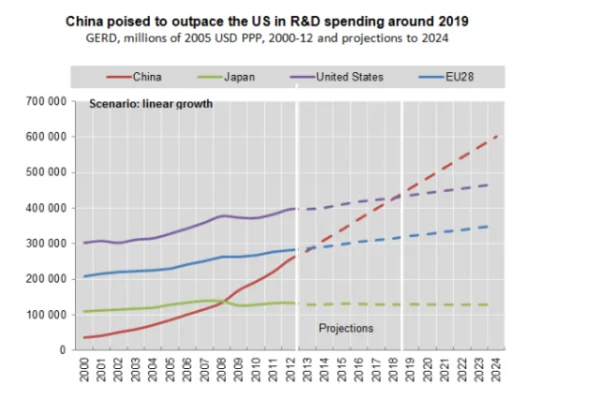While China and the European Union (EU) are continuously pouring billions of dollars into research and development (R&D), the United States is facing a controversial decision: to cut personnel at the National Science Foundation (NSF). This event has raised concerns about the future of science and technology in the U.S., especially as the country faces increasing competition from global rivals. The question is: Can the U.S. maintain its leadership in the technology race, or is this adjustment a sign that the country is falling behind?
NSF recently announced it would cut 168 jobs, which accounts for about 10% of the total workforce at the organization. The main reason for this decision is a reduction in federal funding, aimed at optimizing spending. However, this decision has sparked major concerns about the stagnation of long-term scientific research projects, particularly in key areas such as artificial intelligence (AI), quantum computing, and biotechnology. Scientists and industry experts have expressed worry about the potential consequences the U.S. may face if it lacks the fundamental research programs funded by NSF.

Competition in scientific research is becoming increasingly fierce. While the U.S. is implementing budget cuts, China has announced a 15% increase in its R&D budget for 2024, mainly focusing on cutting-edge technologies such as AI, quantum computing, and semiconductors. The European Union is also stepping up its game by implementing strategies to reduce dependency on the U.S. in key technology sectors, especially in the semiconductor and cybersecurity industries.
In terms of R&D budgets, the U.S. currently spends around 206 billion USD on science and technology research in 2024, but this is a 5% decrease compared to the previous year. In contrast, China will allocate 441 billion USD, a 15% increase from 2023. The European Union, although not disclosing specific figures, is rolling out policies aimed at boosting intra-union investment and reducing reliance on U.S. technology.
The U.S. is currently facing several major challenges in the global technology race. One of the biggest risks is “brain drain.” Policies from China and the EU are attracting talented scientists, causing many Americans to seek opportunities at international organizations or to move to private tech companies. Without effective policies to retain talent, the U.S. may lose some of its brightest minds in science and technology.
Moreover, the shrinkage of resources from NSF will make it difficult for tech companies like Google, Apple, and Microsoft to maintain innovation. These companies primarily focus on applied commercial research, whereas NSF plays a crucial role in providing fundamental research, which is the foundation for long-term technological breakthroughs.
So, what should the U.S. do to maintain its leadership? One of the key strategies is to strengthen public-private partnerships. The government needs to encourage large tech corporations like Google, Tesla, and IBM to participate in fundamental research projects. These companies have the potential to invest heavily in R&D and can help offset some of the budget shortfalls from NSF.
In addition, attracting and retaining talent is a key factor. The U.S. can adopt more flexible visa policies for international scientists and offer attractive financial support packages to keep them in the country. Furthermore, training and supporting young scientists should also be considered to ensure a long-term workforce for the science and technology sector.
Finally, the U.S. needs to focus on strategic technologies such as AI, quantum computing, semiconductors, and renewable energy to avoid falling behind. These fields are rapidly growing and play a critical role in maintaining the U.S.’s competitive position on the global stage.
If the U.S. does not make timely adjustments, the prospect of being surpassed by China in technology is no longer a distant possibility, but could happen within this decade. Can the U.S. quickly adjust its strategy to prevent the decline of its science and technology sector? What solutions will help the country overcome difficulties and maintain its leadership in the global technology race?


HPX24h > Science > NSF Workforce Cuts – Which Path Will the U.S. Take to Stay Competitive in the Global Tech Race?
Tagged Articles
NSF Cuts 168 Jobs – Is the U.S. Scientific Community in Danger?
NSF Job Cuts: Who Benefits and Who Bears the Consequences?
NSF Cuts 168 Jobs Amid Booming Science and Technology: Paradox or Strategic Move?
Top Reads from This Category
Science
New Discovery: How the Brain Manages Emotions and Memory
Science
Discover Blood Testing Technology Without a Visit to the Doctor
Science
Why Do Adult Brains Continue to Generate New Neurons?
Science
Laser Therapy Could Help Regrow Your Teeth – Did You Know?
Science
AI Can Make Life Easier, But Is It Harming Your Ability to Think Critically?
Science
The Shocking Truth About Medical Bandages: Harmful Chemicals Absorbed Through Wounds
Science
Mind-Controlled Prosthetics: A Groundbreaking Advancement in Medicine
Discover New Topics
Health
Forgetfulness Can Bring Unexpected Evolutionary Benefits
Science
Modular Prosthetic Limb Technology: Breakthrough Discovery Enhances Motion for Disabled Individuals
Space
Gamma Ray Bursts and the Key to the Chemical Composition of the Early Universe
Space
Exploring a New Super-Earth: Could It Support Life?
Animals
Stickleback Fish’s Secret to Adapting from Saltwater to Freshwater: How Genetic Mutations Enable Remarkable Adaptation
Animals
Ravens Use Gestures to Find Mates: A New Discovery About Their Intelligence
Healthy Eating
Vegan Keto Diet: Everything You Need To Know
Parenting Tips
Why You Can’t Force Your Child to Live the Way You Do?
Health
What Does a Right-Side Headache Indicate About Your Health?
Fitness
Ketosis: The Key to Accelerating Effective Fat Burning
Parenting Tips
How to Stop Preschoolers from Putting Everything in Their Mouth?
Space
Over 100 Billion Planets in the Milky Way: Astonishing Discoveries About the Universe
Parenting Tips
Why Your Child Might Be Coughing Disruptively During Sleep?